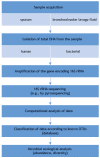The pulmonary microbiome: challenges of a new paradigm
- PMID: 30066739
- PMCID: PMC6467588
- DOI: 10.1590/S1806-37562017000000209
The pulmonary microbiome: challenges of a new paradigm
Abstract
The study of the human microbiome-and, more recently, that of the respiratory system-by means of sophisticated molecular biology techniques, has revealed the immense diversity of microbial colonization in humans, in human health, and in various diseases. Apparently, contrary to what has been believed, there can be nonpathogenic colonization of the lungs by microorganisms such as bacteria, fungi, and viruses. Although this physiological lung microbiome presents low colony density, it presents high diversity. However, some pathological conditions lead to a loss of that diversity, with increasing concentrations of some bacterial genera, to the detriment of others. Although we possess qualitative knowledge of the bacteria present in the lungs in different states of health or disease, that knowledge has advanced to an understanding of the interaction of this microbiota with the local and systemic immune systems, through which it modulates the immune response. Given this intrinsic relationship between the microbiota and the lungs, studies have put forth new concepts about the pathophysiological mechanisms of homeostasis in the respiratory system and the potential dysbiosis in some diseases, such as cystic fibrosis, COPD, asthma, and interstitial lung disease. This departure from the paradigm regarding knowledge of the lung microbiota has made it imperative to improve understanding of the role of the microbiome, in order to identify possible therapeutic targets and to develop innovative clinical approaches. Through this new leap of knowledge, the results of preliminary studies could translate to benefits for our patients.
O estudo do microbioma humano - e, mais recentemente, o do sistema respiratório - através de sofisticadas técnicas de biologia molecular, desvendou a imensa diversidade de colonização microbiana nos seres humanos, sejam saudáveis, sejam portadores de diferentes doenças. Aparentemente, ao contrário do que se acreditava, existe uma colonização não patogênica dos pulmões por microrganismos, como bactérias, fungos e vírus. Esse microbioma pulmonar fisiológico apresenta uma densidade baixa de colônias, porém uma elevada diversidade; por outro lado, alguns estados patológicos levam a uma perda dessa diversidade, com aumento da concentração de alguns gêneros bacterianos em detrimento de outros. Ainda, além do conhecimento qualitativo das bactérias presentes no pulmão em diversos estados de saúde ou de doença, o conhecimento avança para o entendimento da interação que essa microbiota tem com o sistema imune local e sistêmico, modulando a resposta imunológica. Compreendendo essa intrínseca relação entre a microbiota e os pulmões, estudos apresentam novos conceitos sobre os mecanismos fisiopatogênicos da homeostase do sistema respiratório e a possível disbiose em estado de algumas doenças, como fibrose cística, DPOC, asma e doenças intersticiais. Essa quebra de paradigma do conhecimento da microbiota presente nos pulmões fez com que se torne premente entender melhor o papel do microbioma para identificar possíveis alvos terapêuticos e abordagens clínicas inovadoras. Através desse novo salto de conhecimento é que os resultados dos estudos preliminares poderão ser traduzidos em benefícios aos nossos pacientes.
Figures




References
Publication types
MeSH terms
LinkOut - more resources
Full Text Sources
Other Literature Sources
Medical

